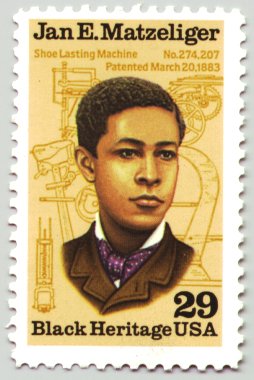Compiled By NAN Staff Writer
News Americas, NEW YORK, NY, Thurs. June 9, 2022: A Caribbean immigrant is credited with inventing the automatic shoe lasting machine, which mechanized the complex process of joining a shoe sole to its upper section which revolutionized the shoe industry.
Jan Matzeliger was born in the then Dutch Guiana, now Suriname, in 1852,. His father, Ernst Matzeliger, was a third generation Dutchman of German descent living in the Dutch Guiana capital city of Paramaribo. He owned and operated the Colonial Shipworks that had been in his family for three generations. His mother was a house slave of African descent; she lived on the plantation of which his father was the owner for a time.
At the age of ten, Jan Matzeliger was apprenticed in the Colonial Ship Works in Paramaribo, where he demonstrated a natural aptitude for machinery and mechanics. He left Dutch Guiana at age 19, and worked as a mechanic on a Dutch East Indies merchant ship for several years before settling in Philadelphia, Pennsylvania, where he first learned the shoe trade.
By 1877, he spoke adequate English even though Dutch was his native tongue, and moved to Massachusetts to pursue his interest in the shoe industry. He eventually went to work in the Harney Brothers Shoe factory.
In the early days of shoemaking, shoes were made mainly by hand. For proper fit, the customer’s feet had to be duplicated in size and form by creating a stone or wooden mold called a “last” from which the shoes were sized and shaped. Since the greatest difficulty in shoemaking was the actual assembly of the soles to the upper shoe, it required great skill to tack and sew the two components together. It was thought that such intricate work could only be done by skilled human hands. As a result, this phase was not yet mechanized and shoe lasters held great power over the shoe industry. They would hold work stoppages without regard for their fellow workers’ desires, resulting in long periods of unemployment for them.
After five years of work, Matzeliger obtained a patent for his invention of an automated shoe laster in 1883. A skilled hand laster could produce 50 pairs in a ten-hour day.
Matzeliger’s machine could produce between 150 and 700 pairs of shoes a day, cutting shoe prices across the nation in half. Matzeliger sacrificed his health working exhausting hours on his invention and not eating over long periods of time. He caught a cold which quickly developed into tuberculosis.
His early death in Lynn, Massachusetts from this disease meant he never saw the full profit of his invention. He died on August 24, 1889, three weeks shy of his 37th birthday.
A 29-cent US postal stamp was issued on September 15, 1991, in honor of Matzeliger.










